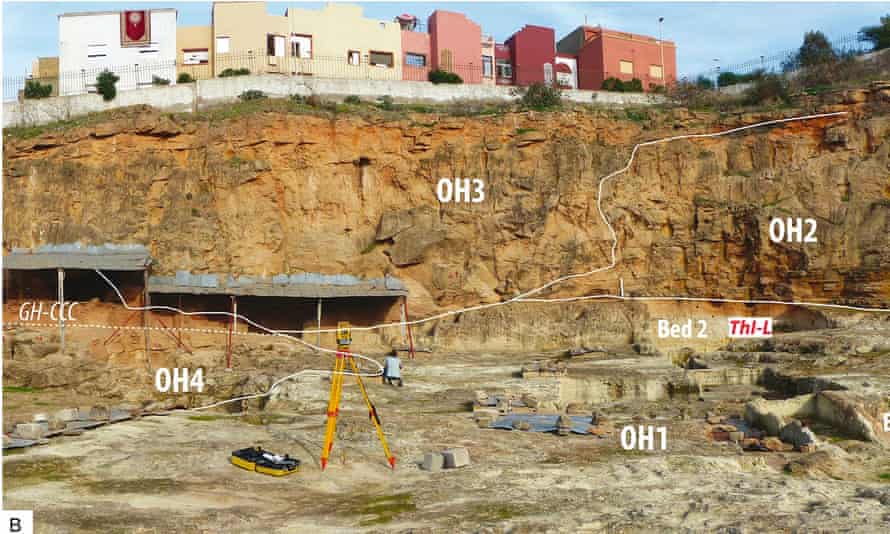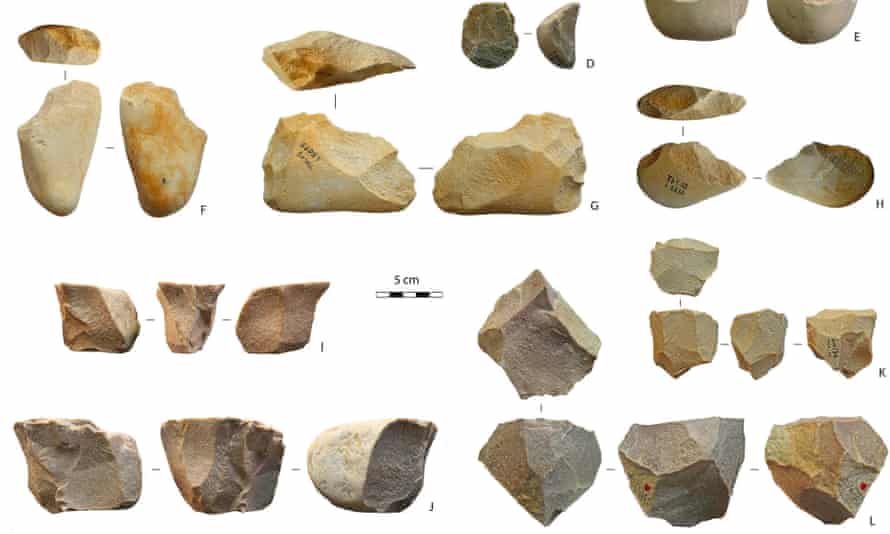Find pushes back by hundreds of thousands of years start of stone-tool industry associated with Homo erectus

The excavations took place at a quarry on the outskirts of Casablanca, Morocco. Photograph: D Lefèvre
Agence France-Presse in Rabat
Wed 28 Jul 2021
Archaeologists in Morocco have announced the discovery of north Africa’s oldest stone age hand-axe manufacturing site, dating back 1.3m years, an international team has reported.
Agence France-Presse in Rabat
Wed 28 Jul 2021
Archaeologists in Morocco have announced the discovery of north Africa’s oldest stone age hand-axe manufacturing site, dating back 1.3m years, an international team has reported.
TOOL MAKING TECHNOLOGY, INDUSTRIAL PRODUCTION FOR ITS AGE*
The find pushes back by hundreds of thousands of years the start date in north Africa of the Acheulian stone-tool industry, associated with the human ancestor Homo erectus, researchers told journalists in Rabat on Wednesday.
The discovery was made during excavations at a quarry on the outskirts of Morocco’s economic capital, Casablanca.
This “contributes to enriching the debate on the emergence of the Acheulian in Africa,” said Abderrahim Mohib, the co-director of the Franco-Moroccan prehistory of Casablanca programme.

The find pushes back by hundreds of thousands of years the start date in north Africa of the Acheulian stone-tool industry, associated with the human ancestor Homo erectus, researchers told journalists in Rabat on Wednesday.
The discovery was made during excavations at a quarry on the outskirts of Morocco’s economic capital, Casablanca.
This “contributes to enriching the debate on the emergence of the Acheulian in Africa,” said Abderrahim Mohib, the co-director of the Franco-Moroccan prehistory of Casablanca programme.

Discoveries from the Thomas Quarry I site outside Casablanca.
Photograph: R Gallotti
Previously, the presence in Morocco of the Acheulian stone-tool industry was thought to date back 700,000 years. The discoveries at the Thomas Quarry I site, made famous in 1969 when a human half mandible was discovered in a cave, mean the Acheulian there is almost twice as old.
The 17-strong team behind the discovery comprised Moroccan, French and Italian researchers, and their findings are based on the study of stone tools extracted from the site.
The Moroccan archaeologist Abdelouahed Ben-Ncer called the news a “chronological rebound”. He said the beginning of the Acheulian in Morocco is now close to the south and east African start dates of 1.6m and 1.8m years ago respectively.
Earlier humans had made do with more primitive pebble tools, known as Oldowan, after their east African-type site. Research at the Casablanca site has been carried out for decades, and has “delivered one of the richest Acheulian assemblages in Africa”, said Mohib. “It is very important because we are talking about prehistoric time, a complex period for which little data exists.”
Mohib said the study also made it possible to attest to “the oldest presence in Morocco of humans” who were “variants of Homo erectus”.
In 2017, the discovery of five fossils estimated at 300,000 years old 100km west of Marrakesh at Jebel Irhoud, overturned evolutionary science when they were designated Homo sapiens.
The Moroccan fossils were much older than some with similar facial characteristics excavated from Omo Kibish in Ethiopia, dating back about 195,000 years.
Previously, the presence in Morocco of the Acheulian stone-tool industry was thought to date back 700,000 years. The discoveries at the Thomas Quarry I site, made famous in 1969 when a human half mandible was discovered in a cave, mean the Acheulian there is almost twice as old.
The 17-strong team behind the discovery comprised Moroccan, French and Italian researchers, and their findings are based on the study of stone tools extracted from the site.
The Moroccan archaeologist Abdelouahed Ben-Ncer called the news a “chronological rebound”. He said the beginning of the Acheulian in Morocco is now close to the south and east African start dates of 1.6m and 1.8m years ago respectively.
Earlier humans had made do with more primitive pebble tools, known as Oldowan, after their east African-type site. Research at the Casablanca site has been carried out for decades, and has “delivered one of the richest Acheulian assemblages in Africa”, said Mohib. “It is very important because we are talking about prehistoric time, a complex period for which little data exists.”
Mohib said the study also made it possible to attest to “the oldest presence in Morocco of humans” who were “variants of Homo erectus”.
In 2017, the discovery of five fossils estimated at 300,000 years old 100km west of Marrakesh at Jebel Irhoud, overturned evolutionary science when they were designated Homo sapiens.
The Moroccan fossils were much older than some with similar facial characteristics excavated from Omo Kibish in Ethiopia, dating back about 195,000 years.
*The Part Played by Labor in the Transition From Ape to Man
This was the decisive step in the transition from ape to man. All extant anthropoid apes can stand erect and move about on their feet alone, but only in case of urgent need and in a very clumsy way. Their natural gait is in a half-erect posture and includes the use of the hands. The majority rest the knuckles of the fist on the ground and, with legs drawn up, swing the body through their long ...
Scientists in Morocco unearth Stone Age hand-axe site dating back 1.3 million years
Issued on: 28/07/2021 -

Text by: NEWS WIRES
Archaeologists in Morocco have announced the discovery of North Africa's oldest Stone Age hand-axe manufacturing site, dating back 1.3 million years, an international team reported Wednesday.
The find pushes back by hundreds of thousands of years the start date in North Africa of the Acheulian stone tool industry associated with a key human ancestor, Homo erectus, researchers on the team told journalists in Rabat.
It was made during excavations at a quarry on the outskirts of the country's economic capital Casablanca.
This "major discovery ... contributes to enriching the debate on the emergence of the Acheulian in Africa," said Abderrahim Mohib, co-director of the Franco-Moroccan "Prehistory of Casablanca" programme.
Before the find, the presence in Morocco of the Acheulian stone tool industry was thought to date back 700,000 years.
New finds at the Thomas Quarry I site, first made famous in 1969 when a human half mandible was discovered in a cave, mean the Acheulian there is almost twice as old.
The 17-strong team behind the discovery comprised Moroccan, French and Italian researchers, and their finding is based on the study of stone tools extracted from the site.
Moroccan archaeologist Abdelouahed Ben Ncer called the news a "chronological rebound".
He said the beginning of the Acheulian in Morocco is now close to the South and East African start dates of 1.6 million and 1.8 million years ago respectively.
Earlier humans had made do with more primitive pebble tools, known as Oldowan after their East African type site.
Research at the Casablanca site has been carried out for decades, and has "delivered one of the richest Acheulian assemblages in Africa", Mohib said.
"It is very important because we are talking about prehistoric time, a complex period for which little data exists."
Mohib said the study also made it possible to attest to "the oldest presence in Morocco of humans" who were "variants of Homo erectus".
In 2017, the discovery of five fossils at Jebel Irhoud in Morocco, estimated at 300,000 years old, overturned evolutionary science when they were designated Homo sapiens.
The Moroccan fossils were much older than some with similar facial characteristics excavated from Omo Kibish in Ethiopia, dating back around 195,000 years.
(AFP)
Issued on: 28/07/2021 -

These Stone-Age tools belong to the same archaeological period as a hand axe, which was unearthed in Morocco in July 2021, and dates back 1.3 million years. © Musée de Toulouse, Creative Commons
Text by: NEWS WIRES
Archaeologists in Morocco have announced the discovery of North Africa's oldest Stone Age hand-axe manufacturing site, dating back 1.3 million years, an international team reported Wednesday.
The find pushes back by hundreds of thousands of years the start date in North Africa of the Acheulian stone tool industry associated with a key human ancestor, Homo erectus, researchers on the team told journalists in Rabat.
It was made during excavations at a quarry on the outskirts of the country's economic capital Casablanca.
This "major discovery ... contributes to enriching the debate on the emergence of the Acheulian in Africa," said Abderrahim Mohib, co-director of the Franco-Moroccan "Prehistory of Casablanca" programme.
Before the find, the presence in Morocco of the Acheulian stone tool industry was thought to date back 700,000 years.
New finds at the Thomas Quarry I site, first made famous in 1969 when a human half mandible was discovered in a cave, mean the Acheulian there is almost twice as old.
The 17-strong team behind the discovery comprised Moroccan, French and Italian researchers, and their finding is based on the study of stone tools extracted from the site.
Moroccan archaeologist Abdelouahed Ben Ncer called the news a "chronological rebound".
He said the beginning of the Acheulian in Morocco is now close to the South and East African start dates of 1.6 million and 1.8 million years ago respectively.
Earlier humans had made do with more primitive pebble tools, known as Oldowan after their East African type site.
Research at the Casablanca site has been carried out for decades, and has "delivered one of the richest Acheulian assemblages in Africa", Mohib said.
"It is very important because we are talking about prehistoric time, a complex period for which little data exists."
Mohib said the study also made it possible to attest to "the oldest presence in Morocco of humans" who were "variants of Homo erectus".
In 2017, the discovery of five fossils at Jebel Irhoud in Morocco, estimated at 300,000 years old, overturned evolutionary science when they were designated Homo sapiens.
The Moroccan fossils were much older than some with similar facial characteristics excavated from Omo Kibish in Ethiopia, dating back around 195,000 years.
(AFP)
No comments:
Post a Comment